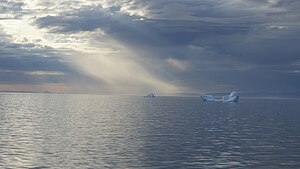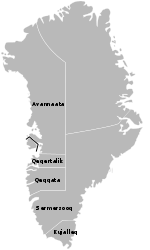Disko Bay

Disko Bay (Greenlandic: Qeqertarsuup tunua; Danish: Disko Bugt[1]) is a bay on the western coast of Greenland. The bay constitutes a wide southeastern inlet of Baffin Bay.
Geography


To the south the coastline is complicated with multiple waterways of skerries and small islands in the Aasiaat archipelago. Qasigiannguit and Ilimanaq are the main settlements in the southeastern inlet, just south of the outflow of Ilulissat Icefjord.
From the north the bay is bounded by Qeqertarsuaq, the largest island on the western coast. North of Ilulissat and west of Aluttoq Island the bay transforms into Sullorsuaq Strait separating Qeqertarsuaq from Nuussuaq Peninsula.[2]
History
This section possibly contains original research. (May 2010) |
Disko Bay has been an important location for centuries. Its coastline was first encountered by Europeans when Erik the Red started a settlement in 985 AD on the more habitable western coast of Greenland. The two settlements, called the Eastern and Western Settlement, were sustenance economies that survived on animal husbandry. Soon after the Western settlement was established, the Norsemen traveled up the coast during the summer thaw and discovered Disko Bay.
Their special interest in this bay was due to its rich sources of Walruses for ivory, seals for their pelts, and whales for a variety of materials. These products became the main exports and source of income for the Greenlandic settlers who traded with Iceland, the British Isles, and mainland Europe. It is important because without its resources the settlements might not have lasted as long as they did.

It is uncertain when the Inuit first started venturing into Disko Bay, and Norse accounts have the area uninhabited when they first explored. Further, Norse accounts document an eventual trade arrangement with the Inuit who came from the north and west. For a time, both parties made peaceful use of the bay. Later accounts[citation needed][dubious – discuss] report fighting and massacres on both sides. However, the Norse left the Greenlandic settlements mainly due to the Little Ice Age that started in the 15th century. There was such a massive shift of temperature that Disko Bay became inaccessible in the warmer summer months. This destroyed the livelihood of the Greenlandic Norse. Even the Eastern settlement, which was below the Arctic Circle became too cold for inhabitation. After this time, until Danish colonization in the 18th century, the Inuit controlled the Disko Bay area, although English and Dutch whalers sometimes visited the area after it was charted during John Davis's third Greenland expedition in 1587.
References
- ^ Christensen, N.O. & al. "Elections in Greenland". Arctic Circular, Vol. 4 (1951), pp. 83–85. Op. cit. "Northern News". Arctic, Vol. 5, No. 1 (Mar 1952), pp. 58–59.
- ^ Nuussuaq, Saga Map, Tage Schjøtt, 1992
Literary references
- Disko Troop, a central character in Rudyard Kipling's novel Captains Courageous, was born on a fishing boat in the vicinity of Disko Bay and subsequently named after it.
Sources
- Brown, Berit ed. Nordic Experiences: Exploration of Scandinavian Cultures. Greenwood Press. Westport, CT. 1997.
- Diamond, Jared. Collapse. Penguin Press Ltd. London, England. 2005.
- Enterline, James Robert. Erikson, Eskimos, and Columbus. Johns Hopkins University Press. Baltimore, MD. 2002.
- Haywood, John. The Encyclopedia of the Viking Age. Thanes and Hudson, Inc. New York, NY. 2000.
- Ingstad, Helge. Friis, Erik trans. Westard to Vinland:The Discovery of Pre-Columbian Norse House-sites in North America. St. Martin’s Press. New York, NY. 1969.
- Wahlgren, Erik. The Vikings and America. Thames and Hudson, Inc. New York, NY. 1986.
- Wooding, Jonathan. The Vikings. Rizzoli International Pub. Inc. New York, NY. 1997.
External links
- www.disko.gl Site with information and interactive maps of the Disko Bay area.

